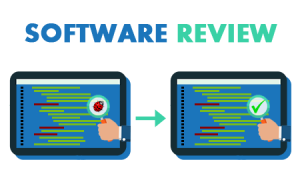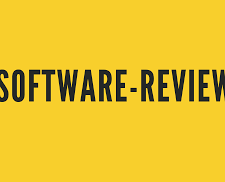Comprehensive Guide to Software Reviews: How to Choose the Best for Your Needs
In the digital age, there are countless software solutions accessible for every purpose, from productivity applications to intricate creative programs. With so many choices, how can you know which one is right for you? This is where software reviews come into play. Software reviews are useful resources that provide insights into a product’s functionality, usability, and overall quality. They offer a complete study of numerous software solutions, helping you avoid making costly mistakes and select the best tools that meet your demands.
Buy NowReading software reviews is more than simply a tool to evaluate features; it also helps you understand how others have interacted with the product, if it’s dependable, and if it lives up to its claims. Whether you’re a rookie, a business owner, or a tech enthusiast, software evaluations can make all the difference in your decision-making process.
Why Software Reviews Matter
Software reviews are a significant component of the buying process. They enable potential users to evaluate different software before committing. By reading reviews, you get a firsthand glimpse at a product’s strengths and weaknesses based on real customer experiences. This helps you determine if the software will satisfy your specific demands.
Unlike marketing materials or product promotions, reviews provide a more neutral perspective. They are written by persons who have used the product and can highlight aspects that may not be visible at first glance. Reviews offer openness and allow you to make a well-informed selection without having to encounter any potential hazards firsthand.
The Importance of Reading Multiple Software Reviews
It’s vital to avoid basing your judgement on a single review. A single review might not accurately represent the software’s overall quality. Users can have different expectations, demands, or concerns that are not applicable to your scenario. Therefore, reading various software reviews from diverse sources will help you obtain a full knowledge.
Look for patterns in the reviews. For example, if numerous users appreciate the software’s simplicity of use or mention comparable problems with the UI, those are certainly essential elements to examine. By reading diverse perspectives, you can make a more balanced and knowledgeable judgement.
Understanding the Components of a Software Review
A thorough software evaluation often covers numerous critical components. These components provide insight into how the software functions and whether it fits the users’ needs. The main components of a good software review include:
- Functionality – Does the software do what it promises? Functionality addresses the essential functions and how well they work. It’s one of the most significant aspects to analyse when reading reviews.
- Ease of Use – A good review should indicate how easy or difficult it is to utilise the product. Is the interface intuitive? Is there a significant learning curve?
- Customer Support – How responsive is customer service when concerns arise? Reviews generally note the quality of technical help and how quickly issues are rectified.
- Pricing – Many reviews provide information regarding the pricing structure. Is the program cost-effective for its capabilities, or is it overpriced?
- Security – In today’s digital landscape, software security is vital. Reviews should include if the software has suitable security safeguards, particularly if it handles sensitive data.
Key Features to Look for in Software Reviews
Understanding which features are most relevant to your needs is crucial when reading software evaluations. Below are some of the main elements to look for:
- Functionality – Reviews should address the primary functionalities supplied by the product. Pay attention to how it solves certain problems or tasks.
- Ease of Use – The user interface (UI) and experience (UX) are crucial in evaluating if the software is worth using long-term. Look for mentions of intuitive designs or, alternatively, perplexing layouts.
- Performance – Does the software run smoothly without frequent crashes or bugs? Performance reviews should highlight how the software handles demanding tasks or multi-tasking.
- Integration Capabilities – Does the software integrate with other tools you use? This can be a big impact in your selection.
How Software Reviews Help You Avoid Mistakes
Choosing the wrong software can be costly and time-consuming. Reading several software evaluations assists you to prevent these costly blunders by offering early alerts about potential difficulties. Reviews often highlight common concerns that users have, such as bad customer service, lack of functionality, or hidden fees.
For example, a software could seem fantastic initially, but evaluations may indicate that it has frequent faults or missing a certain function you require. Without reading evaluations, you might only find out about these flaws after spending your money or devoting effort in learning the system.
Types of Software Reviews
When searching for software reviews, you’ll discover several formats and sources. Here are some common types:
- Professional Reviews – These reviews are prepared by specialists who have in-depth knowledge of the software and industry. They provide a full description of the software’s features, benefits, and limitations.
- User Reviews – These reviews come from regular customers who have hands-on experience with the product. User reviews can provide insights into real-world usability and customer service experiences.
- Video Reviews – Some folks prefer seeing video reviews. These can provide a more interactive and interesting method to explore the software’s capabilities and functionality.
- Comparison Reviews – These evaluations evaluate several software solutions, giving you examine side-by-side comparisons of features, cost, and performance.
How to Analyze Software Reviews Effectively
When you read a software review, it’s crucial to know how to assess it effectively:
- Identify Patterns – Look for recurrent topics in several reviews. If numerous users laud the same feature, that’s a positive sign. Similarly, many bad evaluations regarding a certain issue could be a red flag.
- Assess Credibility – Verify the credibility of the reviewer or review platform. Trustworthy websites and knowledgeable reviews tend to provide more accurate and dependable information.
- Look for Specificity – Reviews that include precise facts (e.g., “The software took 30 minutes to process X task”) are more helpful than generic opinions like “This software is great.”
- Consider the Reviewer’s Context – Everyone utilises software differently. For instance, a software that works excellent for a business might not meet a casual user’s demands.
Common Mistakes to Avoid When Reading Software Reviews
- Overvaluing a Single Review – One review should never be the sole element in your decision-making. Rely on a compilation of reviews to gain a thorough image of the software.
- Ignoring Negative Reviews – Negative feedback is just as valuable as favourable reviews. Often, people highlight hidden issues or features that aren’t visible at first sight.
- Believing All Reviews Are Unbiased – Some reviews may be sponsored or prejudiced. Look for verified user reviews or reviews from reputable sources to prevent promotional content.
How to Choose Software Based on Reviews
After reading many software reviews, you can begin to limit down your selections. Consider these steps to make the best decision:
- Identify Your Needs – What is the software meant to do? Does it offer the functionality necessary to fulfil your tasks? Choose software that corresponds with your needs.
- Evaluate Features and Pricing – Compare features across different software options. Does the program justify its cost? Are there hidden costs or subscriptions?
- Customer Support and Security – Consider how responsive customer assistance is and whether the product has robust security features to protect your data.
Best Places to Read Software Reviews
- Trustpilot – A generally trusted review site that covers a variety of software and service companies.
- Capterra – Specializes on reviews for business and enterprise software, delivering a broad list of software options.
- G2 – G2 is one of the most prominent review sites for software. It allows consumers to compare applications and delivers thorough breakdowns.
- TechRadar – Offers expert assessments on both consumer and corporate software, along with extensive performance evaluations.
How to Write a Software Review
If you’ve tried a piece of software and wish to help others, submitting a review can be beneficial. A good review should:
- Provide an overview of what the software does and its purpose.
- Share your personal experience, including what worked and what didn’t.
- Mention any obstacles you had and how they were overcome.
- Include your overall satisfaction rating, whether you’d suggest it, and why.
How Software Reviews Impact Software Development
Developers typically rely on software feedback to improve their products. Feedback from real users helps discover bugs, design faults, and features that need improvement. Positive ratings motivate developers to keep enhancing the program, while negative reviews assist them find and fix specific flaws.
The Future of Software Reviews
As technology continues to evolve, software reviews will remain a crucial element of the decision-making process. With the growth of artificial intelligence, we may even see more personalized and predictive reviews tailored to specific requirements. As the software market increases, evaluations will help limit down possibilities and make it easier to choose the best solution.
Buy NowConclusion
In today’s digital landscape, software evaluations are a crucial tool for making educated selections. By understanding the components of reviews, knowing how to assess them, and reading a variety of perspectives, you can ensure that you purchase the finest software for your needs. Whether you’re searching for a corporate tool, a creative app, or something for personal use, reviews provide insights into the software’s features, cost, and performance. So, always take the time to read numerous software reviews before making a purchase.
Frequently Asked Questions (FAQs) About Software Reviews
- Why are software reviews important? Reviews assist consumers make informed selections, delivering insights into software functionality, pricing, and general quality based on genuine experiences.
- How can I determine if a software review is reliable? Verify reviews from trustworthy sources and look for full feedback, covering both benefits and negatives.
- What should I look for in a software review? Focus on the features, convenience of use, customer service, security, and any potential difficulties raised by users.
- Are user reviews more valuable than professional reviews? Both have merit. User reviews offer real-world experience, while professional evaluations provide expert analysis and context.
- Can I trust all internet software reviews? Not all reviews are unbiased. Look for genuine reviews and be sceptical of reviews that look too enthusiastic or negative.
- How can I create an excellent software review? Be honest and specific. Mention both the benefits and the downsides, and share your personal experience with the software.
- Do software reviews effect the development of the product? Yes, developers typically take feedback from reviews to improve the software, correct errors, and add new features.
- What are the greatest websites for software reviews? Trustpilot, G2, Capterra, and TechRadar are some of the leading venues for reading software evaluations.
- How can I obtain unbiased software reviews? Look for evaluations from well-known platforms and cross-reference multiple sources for a balanced perspective.
- What if I disagree with a software review? Everyone has distinct demands and experiences. Consider reading other reviews to see if others share your perspective.


